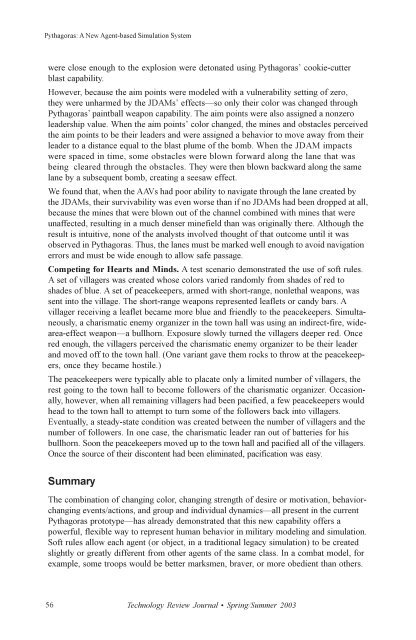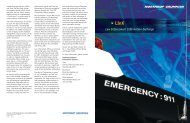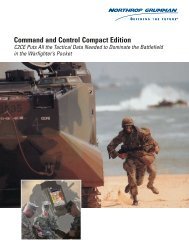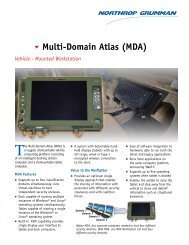Pythagoras: A New Agent-based Simulation System - Northrop ...
Pythagoras: A New Agent-based Simulation System - Northrop ...
Pythagoras: A New Agent-based Simulation System - Northrop ...
You also want an ePaper? Increase the reach of your titles
YUMPU automatically turns print PDFs into web optimized ePapers that Google loves.
<strong>Pythagoras</strong>: A <strong>New</strong> <strong>Agent</strong>-<strong>based</strong> <strong>Simulation</strong> <strong>System</strong><br />
were close enough to the explosion were detonated using <strong>Pythagoras</strong>’ cookie-cutter<br />
blast capability.<br />
However, because the aim points were modeled with a vulnerability setting of zero,<br />
they were unharmed by the JDAMs’ effects—so only their color was changed through<br />
<strong>Pythagoras</strong>’ paintball weapon capability. The aim points were also assigned a nonzero<br />
leadership value. When the aim points’ color changed, the mines and obstacles perceived<br />
the aim points to be their leaders and were assigned a behavior to move away from their<br />
leader to a distance equal to the blast plume of the bomb. When the JDAM impacts<br />
were spaced in time, some obstacles were blown forward along the lane that was<br />
being cleared through the obstacles. They were then blown backward along the same<br />
lane by a subsequent bomb, creating a seesaw effect.<br />
We found that, when the AAVs had poor ability to navigate through the lane created by<br />
the JDAMs, their survivability was even worse than if no JDAMs had been dropped at all,<br />
because the mines that were blown out of the channel combined with mines that were<br />
unaffected, resulting in a much denser minefield than was originally there. Although the<br />
result is intuitive, none of the analysts involved thought of that outcome until it was<br />
observed in <strong>Pythagoras</strong>. Thus, the lanes must be marked well enough to avoid navigation<br />
errors and must be wide enough to allow safe passage.<br />
Competing for Hearts and Minds. A test scenario demonstrated the use of soft rules.<br />
A set of villagers was created whose colors varied randomly from shades of red to<br />
shades of blue. A set of peacekeepers, armed with short-range, nonlethal weapons, was<br />
sent into the village. The short-range weapons represented leaflets or candy bars. A<br />
villager receiving a leaflet became more blue and friendly to the peacekeepers. Simultaneously,<br />
a charismatic enemy organizer in the town hall was using an indirect-fire, widearea-effect<br />
weapon—a bullhorn. Exposure slowly turned the villagers deeper red. Once<br />
red enough, the villagers perceived the charismatic enemy organizer to be their leader<br />
and moved off to the town hall. (One variant gave them rocks to throw at the peacekeepers,<br />
once they became hostile.)<br />
The peacekeepers were typically able to placate only a limited number of villagers, the<br />
rest going to the town hall to become followers of the charismatic organizer. Occasionally,<br />
however, when all remaining villagers had been pacified, a few peacekeepers would<br />
head to the town hall to attempt to turn some of the followers back into villagers.<br />
Eventually, a steady-state condition was created between the number of villagers and the<br />
number of followers. In one case, the charismatic leader ran out of batteries for his<br />
bullhorn. Soon the peacekeepers moved up to the town hall and pacified all of the villagers.<br />
Once the source of their discontent had been eliminated, pacification was easy.<br />
Summary<br />
The combination of changing color, changing strength of desire or motivation, behaviorchanging<br />
events/actions, and group and individual dynamics—all present in the current<br />
<strong>Pythagoras</strong> prototype—has already demonstrated that this new capability offers a<br />
powerful, flexible way to represent human behavior in military modeling and simulation.<br />
Soft rules allow each agent (or object, in a traditional legacy simulation) to be created<br />
slightly or greatly different from other agents of the same class. In a combat model, for<br />
example, some troops would be better marksmen, braver, or more obedient than others.<br />
56<br />
Technology Review Journal • Spring/Summer 2003






